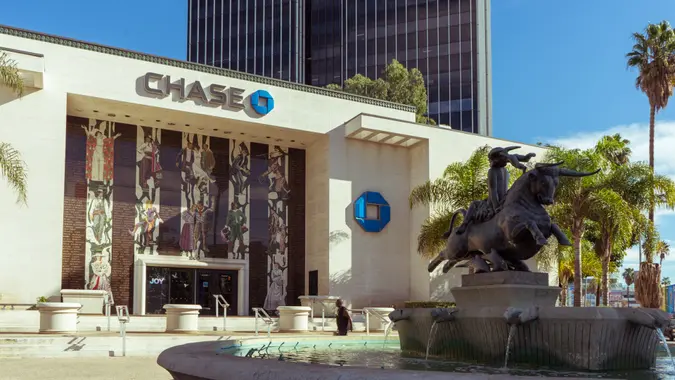What Is a Cash Management Account?

Commitment to Our Readers
GOBankingRates' editorial team is committed to bringing you unbiased reviews and information. We use data-driven methodologies to evaluate financial products and services - our reviews and ratings are not influenced by advertisers. You can read more about our editorial guidelines and our products and services review methodology.

20 Years
Helping You Live Richer

Reviewed
by Experts

Trusted by
Millions of Readers
A cash management account is a type of deposit account that combines the features of several other types of accounts, like checking accounts, savings accounts, high-yield cash accounts and investment accounts. This can simplify your banking. Rather than being offered by traditional banks, cash management accounts are usually offered by brokerage or investment firms.
Cash management accounts have some key benefits, but also come with some drawbacks and limitations that you should consider.
How Cash Management Accounts Work
Cash management accounts allow account holders to access more features in fewer accounts. This allows you to save, spend and invest your money seamlessly, blending the functions of checking, savings and brokerage accounts.
Key Features of Cash Management Accounts
CMA features vary depending on the financial institution, but they often include interest on your balance, a debit card or ATM access, online payment services and more. Here’s an overview:
- Banking and investment: No need for separate accounts. Your cash flows between deposit accounts and investment accounts.
- Interest-earning: Competitive interest rates on balances
- Ease of use: Debit cards, check-writing, online payments and mobile apps make many cash management accounts user-friendly.
- Fast transfers: Many cash management accounts offer instant fund transfers.
- Insurance protection: Most are insured by the FDIC or SIPC up to $250,000. Some have even higher FDIC limits.
Benefits of Using a CMA
Cash management accounts often have features that are more attractive than having many separate accounts.
Higher Interest Rates
These accounts often have higher annual percentage yields than regular savings accounts.
Convenience
With banking and investment tools in one place, cash management accounts simplify managing finances on many multiple platforms, allowing you to track spending, savings and investments from a single dashboard.
Linking to Your Investments
You can fund investments instantly, without fees, because they are linked directly to a brokerage account.
Low or No Fees
Often have low or no fees and some have no account minimum.
Accessibility
You can access your funds anytime, anywhere thanks to features such as debit cards, ATM access, check-writing and online payments.
Higher FDIC Limits
Traditional deposit accounts are insured to $250,000. However, many institutions offer a cash management account partnership with many other banks to insure accounts for much higher limits. For instance, uninvested money in Fidelity’s cash management account is insured up to $5,000,000.
Types of Cash Management Accounts
Cash management accounts are offered by three primary types of financial institutions: traditional banks, brokerage firms and fintech companies. Each one caters to different financial needs.
Banks
Traditional banks often provide interest-bearing cash management accounts with FDIC insurance up to $250,000 and the ability to move money easily. Traditional banks also often offer mortgages, credit cards, and personal loans, and are a good choice for customers who want an all-in-one banking solution. But bank-based CMAs sometimes lack sophisticated investment integration or lower interest rates than brokerage firms.
Brokerage Firms
Brokerage firms are popular with those focused on investing. CMAs offered by these institutions are designed to allow for seamless transfers between cash balances and investment portfolios. They often have higher interest rates, easy fund accessibility, and direct integration with brokerage services, and up to $5,000,000 in FDIC insurance for uninvested funds.
Fintechs
Fintech platforms, such as Betterment, Marygold & Co., Wealthfront, and others, are redefining the landscape with features tailored to tech-savvy users. These companies often offer cash management accounts with higher APYs than both banks and brokerage firms, no fees and advanced digital tools. Fintech cash management accounts often include features like automated savings, spending insights and goal-setting tools.
Can You Invest with a Cash Management Account?
Yes, if the cash management account is linked to a brokerage account. Most brokerage-based CMAs are directly connected to investment accounts, which means transferring funds for investing is instant.
Benefits of Investing from CMAs
Investing through a cash management account is often more efficient since they streamline the steps of funding investments with seamless transfers between deposit accounts and investment accounts.
Another potential benefit is cost savings. Transfer fees are often waived for moving funds between investment accounts, making cash management accounts a practical choice for avid or frequent investors who want to minimize fees.
Liquidity is another advantage. Cash management accounts ensure funds remain accessible. They also allow you to maximize compounding returns because you ensure your funds are consistently creating long-term growth.
Examples of Investment-Integrated CMAs
- Fidelity Cash Management Account: A good option with complete integration with brokerage service. It offers a full range of checking and savings features and access to a trusted investment platform. Deposits are also insured up to $5 million.
- Vanguard Cash Plus Account: Pays APY on balances and can be linked to an investment account for smooth and instant transactions. FDIC insured up to $1.25 million.
- Empower Personal Cash Account: Pays 3.75% APY and links to your investment accounts. Also comes with $5 million FDIC insurance and has no daily minimum balance requirement.
Cash Management Account Rates: What To Expect
Here’s what you might expect .
CMAs vs. Traditional Accounts
With so many traditional and online banks to choose from, the rate differences between most CMAs and high-interest savings accounts are minimal, with some high-interest savings accounts paying up to 4.75% APY. Traditional savings and checking accounts do pay less, but it is still possible to find savings and checking accounts paying 3%, 4% or even 5% at some credit unions.
Factors Affecting Rates
Interest rates are affected by many factors, including the state of the economy, supply and demand and inflation. These in turn affect the Federal Reserve policy, which raises and lowers interest rates. Finally, good old competition between financial institutions plays a role.
Best Practices for Maximizing Returns
- Research your options. There are any number of cash management accounts offered, so shopping around is wise.
- If there is a minimum balance requirement, make sure you’re meeting this so you aren’t charged additional fees or be moved to a lower-interest tier.
- Thoroughly read the account information to ensure there are no hidden fees.
- Compare rates regularly. These days it’s not that difficult to switch accounts.
Choosing the Best Cash Management Account
So you’ve decided to open a cash management account. It’s important to compare their various features to make sure you’re choosing the best option for you. Here are a few things to consider:
Features To Look For
- Desirable features: First and foremost, make sure the account you open has the features you need. Desired features might include a debit card, ATM access, check-writing privileges, online bill pay and more.
- High APY: If you want to earn interest in your , shop around to find one with a high APY — and make sure you read the fine print to understand what requirements you need to meet and how much of your balance that high APY applies to.
- Low or no fees: Look into whether each charges monthly fees and whether there are ways to avoid them, such as by maintaining a certain monthly balance.
- FDIC insurance: Most are FDIC-insured, but it’s important to find an account that has a high enough insurance limit to cover your entire balance.
- Minimum balance requirements: Check if the CMA you’re considering has a minimum balance requirement and, if it does, whether you believe you’ll be able to reach it each month. Failing to maintain that minimum balance can result in high fees and potentially even having your account closed.
- Connectivity: Many cash management accounts are offered by brokerage firms and can connect directly to your brokerage account. It may be best to choose an account with the same brokerage firm.
Top-Rated CMAs
There are many CMAs to choose from. Here are a few offering high returns and solid insurance.
| Institution | APY | Minimum Balance | FDIC Insurance |
|---|---|---|---|
| Empower | 3.75% | None | $5 million |
| Betterment | None | $2 million | |
| Wealthfront | None | $8 million | |
| Vanguard | None | $1.25 million |
Risks and Limitations of CMAs
While cash management accounts might sound great, there are some potential drawbacks and limits.
Insurance Coverage
FDIC Insurance protects deposited amounts in your non-investment account. In most banks, this protection is limited to $250,000. However, in many institutions offering CMAs, it can be as high is $5 million, or even $8 million.
SIPC Insurance protects you from losses of your cash or investment money, including stocks and bonds. This insurance covers up to $500,000, including $250,000 for cash.
Potential Fees, Hidden Costs and Liquidity Concerns
Some cash management accounts do charge fees, such as annual fees or wire transfer fees and more.
Economic Risks
Your APY is affected by many factors, such as the state of the economy, market forces, and more. So earning the return you were advertised when signing up is not guaranteed.
How To Open a Cash Management Account
In our tech-forward world, opening and funding a cash management account is usually an easy process. Here are the steps to follow:
- Research providers. Compare features, fees and interest rates.
- Prepare documentation. Have your documents ready. Depending on the provider you choose, these could include Social Security number, date of birth, address, phone number and employment details. You might have to provide proof.
- Apply online. Most cash management accounts offer an easy and fast online application process.
- Fund your account. You can transfer money from another checking or savings account for your initial deposit.
- Set up alerts. It’s important to enable notifications for balances and transactions to monitor activity.
Tips for Comparing Providers
- Read reviews to gauge customer satisfaction.
- Use comparison tools to check out rates, features and fees side by side.
- Prioritize institutions with strong security and, if it’s important to you, good customer support.
- Look for institutions with a track record of financial stability.
- Decide on the features important to you and your financial needs. For instance, perhaps it’s worth a small annual fee for a very high APY.
Erin Gobler contributed to the reporting for this article.
Our in-house research team and on-site financial experts work together to create content that’s accurate, impartial, and up to date. We fact-check every single statistic, quote and fact using trusted primary resources to make sure the information we provide is correct. You can learn more about GOBankingRates’ processes and standards in our editorial policy.
- Fidelity. 2024. "What is a cash management account?"
- Yahoo Finance. 2024. "This fintech app just launched a 6% APY cash management account to help boost holiday savings."
- First Financial Bank. "Why are interest rates rising?"
 Written by
Written by  Edited by
Edited by 

























